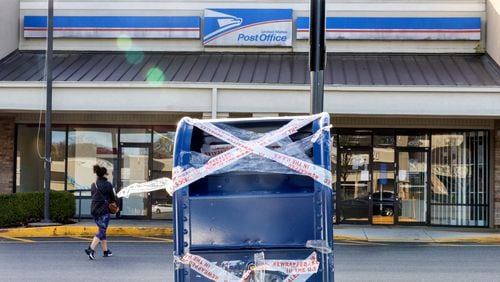I have a nightly ritual that is likely familiar to many other Atlantans.
I walk to the edge of the driveway, open my mailbox, lean over and peer inside. But, for nearly a week earlier this spring, I went to the mailbox each evening only to find … nothing.
No cards. No letters. No bills. No annoying direct-mail advertising.
I was so baffled that I added an extra step to this routine: I would shove my hand inside the box and slide it along the dark gray metal, as if mail that I couldn’t see with my eyes would materialize at the touch.
Then I started to panic. How many times had I read online that a sudden decline of mail in your mailbox is a sign of identity theft, mail theft or just theft in general?
As it turns out, I wasn’t a victim of a crime. The problems were bigger than me and my mail.
The entire Atlanta region has been experiencing significant mail delays due to hiccups at a new processing and distribution center in Palmetto. The center opened in February as part of the Delivering for America (DFA) plan, a 10-year restructuring of the United States Postal Service (USPS) intended to build long-term viability.
During a contentious congressional committee hearing last month, U.S. Postmaster General Louis DeJoy said the postal service is in the middle of correcting “years of failed practices” and that all of this will get better once the transition is done.
But in the meantime, the public is learning it can’t rely on the postal service as it once did. For months, people have been complaining not just about delivery, but about drop boxes taped off and post offices closed during standard business hours. In the end, the reliability issue might prove to be more of a threat to the long-term viability of the USPS.
Nowadays, every time I need to send an important package or letter, I debate whether I should use FedEx, UPS or another delivery service.
To say that DeJoy’s plan for modernizing the USPS has not gone smoothly is a huge understatement.
The first Regional Processing & Distribution Center (RPDC) like the one in Palmetto opened in Richmond, Virginia, which quickly became one of the postal service’s worst-performing regions. The same thing happened in Houston and then in Atlanta, which had such a stunningly bad drop in on time delivery rates that U.S. Sens. Jon Ossoff and Raphael Warnock jumped in the fray. DeJoy stated in the April committee hearing that the challenges in Georgia were the result of having to move 2,000 people from many different plants to a single location.
In a May 9 letter addressed to Sen. Gary Peters, DeJoy agreed to temporarily halt any changes to facilities under review for consolidation. The postmaster general said he would not move forward without advising lawmakers and would implement the plans at a more moderate pace.
Still, he defended his vision for addressing problems at the USPS. The steps he’s taking, he said, are important to achieve ”a network that can provide greater service reliability in a cost-effective manner,” with new equipment, improved maintenance, better working conditions and no layoffs.
The post office has been losing money since 2006, but he said changes since the launch of DFA have reduced operating losses by $15 billion. Had it not been for inflation, the agency would have come close to breaking even in 2022.
That’s great, but what does that matter to those of us who can’t get our mail?
Lately, my mailbox is flush with flyers, marketing mail and catalogs (all of which have a different mailing process than single letters dropped at the post office). But, despite seeing scans of inbound mail in my Informed Delivery account, which gives registrants a sneak preview of mail headed their way, not all of it is arriving.
Some letters and Mother’s Day cards still haven’t made it into my mailbox, and I saw the scans a week ago. I can almost picture this ephemera strewn about in a postal facility, waiting to find its way to me.
I want our postal service, a 250-year-old institution, to thrive. I don’t want to keep looking for alternatives to using the USPS. The post office is one of the only government agencies that touches every American, from cities to suburbs to rural areas. At a time when we find ourselves so fractured, there is something comforting in the thought that we are still connected through this network.
Maybe one day we can return to the days when nothing — rain, snow, heat or the “gloom of night” —could stop the USPS from getting our mail where it needed to go.
DeJoy seems confident in his plan. But he still has much to prove.
Read more on the Real Life blog (www.ajc.com/opinion/real-life-blog/) and find Nedra on Facebook (www.facebook.com/AJCRealLifeColumn) and Twitter (@nrhoneajc) or email her at nedra.rhone@ajc.com.








